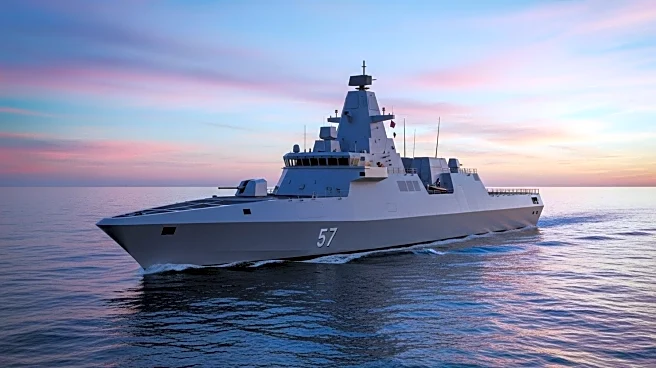What's Happening?
Singapore is preparing to launch its first multirole combat vessel (MRCV) in October 2025, marking a significant advancement in the Republic of Singapore Navy's fleet renewal program. This launch comes a year after the keel for the first vessel was laid down in October 2024, and follows the cutting of steel for the second ship in April 2025. The MRCV program was initiated to replace the aging Victory-class corvettes, which have been in service since 1990. In March 2023, Singapore's Ministry of Defence awarded ST Engineering the contract to design and build six MRCVs. The vessels are being co-developed with Saab, following a memorandum of understanding with the Defence Science and Technology Agency (DSTA). The new ship will be the largest surface combatant operated by Singapore, displacing about 8,000 tonnes and measuring approximately 150 meters in length. It features advanced propulsion systems and sonar capabilities for anti-submarine warfare.
Why It's Important?
The launch of the MRCV represents a strategic enhancement of Singapore's naval capabilities, ensuring the Republic of Singapore Navy remains equipped to address modern maritime challenges. The replacement of the Victory-class corvettes with these advanced vessels underscores Singapore's commitment to maintaining a robust defense posture in the region. The collaboration with Saab and ST Engineering highlights the importance of international partnerships in defense technology development. This move is likely to bolster Singapore's maritime security and influence in Southeast Asia, potentially affecting regional naval dynamics and defense strategies. The introduction of these vessels may also stimulate technological advancements and economic activity within Singapore's defense sector.
What's Next?
Following the launch of the first MRCV, Singapore will continue its fleet renewal program with the construction of additional vessels. The ongoing collaboration with Saab and ST Engineering suggests further technological innovations and enhancements in naval capabilities. As the new vessels become operational, Singapore may engage in more extensive maritime exercises and collaborations with regional and international partners. The deployment of these vessels could lead to strategic shifts in regional maritime security policies, prompting neighboring countries to reassess their naval strategies and capabilities.
Beyond the Headlines
The development and launch of the MRCV may have broader implications for Singapore's defense policy and international relations. The focus on advanced naval technology reflects a strategic pivot towards enhancing maritime security in response to evolving regional threats. This initiative could influence Singapore's defense procurement strategies and its role in international defense collaborations. Additionally, the emphasis on technological innovation in defense may spur growth in related industries, contributing to Singapore's economic development and technological leadership in the region.











